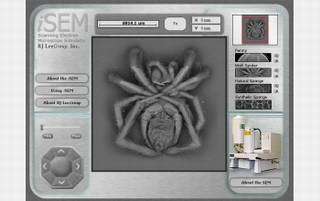Education Magnified 100,000X

Kids have always had a fascination with the other-worldly images produced by a scanning electron microscope (SEM): ants sitting on microchip picnic tables, salt crystals in gritty detail, the scales of a butterfly wing.
Now, a team of researchers and educators has created a CD-ROM and Web-based software to generate some of the capabilities--and teaching potential--of an SEM using personal computers in a classroom.
"Our goal is to develop next-generation virtual laboratory technology to provide educators access to advanced analytical instruments rarely found in a high school, or even a college," says Gary Casuccio of the RJ Lee Group, principal investigator on the iSEM Project. "The iSEM represents our first step in this direction."
Rooted in some of the same techniques researchers execute in an SEM lab, students can use the technology to explore objects. Called iSEM, for Interactive Scanning Electron Microscope, the system displays pre-installed, high-resolution images that students can observe and precisely measure as if they were operating their own $200,000 analytical instrument.
"Today's students use technology like their parent's generation used books – it is an integral part of their lives," says Lynn Landis, an 8th-grade science teacher from South Fayette Middle School in Pittsburgh and a consultant for the iSEM Project. "By bringing this technology to my classroom, I feel that I will be 'updating' school and tying it to real life activities."
From zooming in and measuring the fangs of a spider to analyzing the chemistry of minerals in a meteorite, elementary school-aged children can run experiments they might not otherwise see outside of a graduate school education.
"iSEM is a version of the SEM tool that is affordable even to schools with relatively meager resources," says Sally Nerlove, the NSF officer who oversaw the iSEM award. "This has the potential to motivate and prepare students for professions that benefit from advanced microscopy, such as electronics, medicine, forensics and the emerging area of nanotechnology."
Source: NSF
















